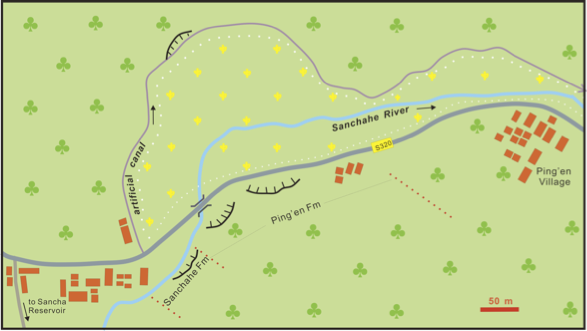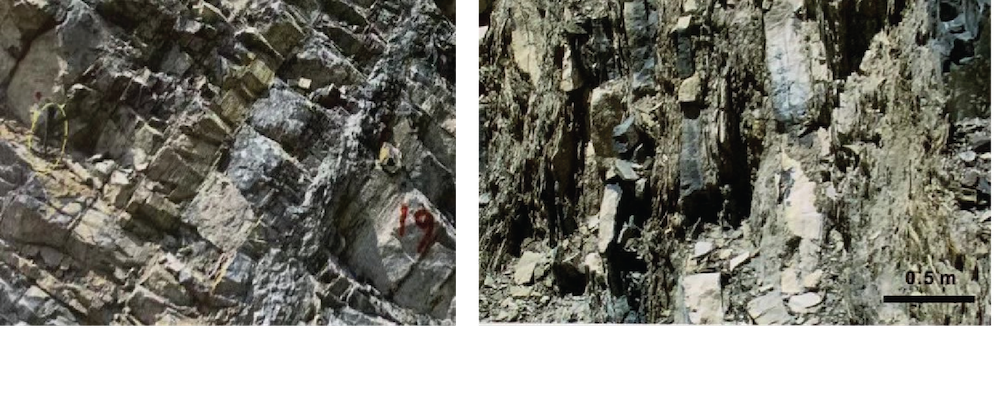Sanchahe Fm
Type Locality and Naming
It was named by Xian Siyuan et al. in 1980. The type section is located at east of Sanchahe Reservoir of Ping’en Tun, Nachi Village in Napo County (23o16’ 37.35’’N - 105o 57’ 35.80’’E), along the small stream (Sanchahe River) of south side of the County Road No. S320.
[Figure Map showing the location of the stratotype of Ping’en Formation in the south side of County Road No. S320 at Ping’en Village, Napo County of Guangxi.]
Lithology and Thickness
Limestone. The formation can be subdivided into three units, just based on gross lithologic differences and on morphology of weathering profiles. Lower part is characterized by dark grayish thick-bedded and massive limestones, containing few conodonts, about 16 m thick. Middle part is composed mainly of dark grayish medium bedded well-stratified micritic limestones, 22 m thick. Upper part comprises the medium-thin bedded nodular limestone and micritic limestone intercalated with up to 2 cm thick brown-colored mudstones, about 6.8 m thick, devoid of chert. The nodular limestones are very distinct at the top showing the irregular nodules varying in size and shapes encircled by wavy fine clayey bands. However, the stylolites are not present.
[Figure Outcrops of Sanchahe Formation in the type locality of Ping’en. A-Section of the upper unit showing the nodular limestones and bedded micritic limestone with mudstone interbeds. B-Partial view of the middle unit, the dash line indicates the boundary between middle and upper units. C-Nodular limestone of the Upper Unit. D-Alternating limestone and brown mudstone of the Upper unit (lengths of hammer 28 cm and lens 2.8 cm). E-The basal thick-bedded limestone of the Formation with karst caves and solution cavities.]
Relationships and Distribution
Lower contact
The basal contact with the underlying Pojiao Fm Shale is sharp. It is separated by a thick-bedded limestone with karst caves and solution cavities at the base of Sanchahe Fm.
Upper contact
It is conformable contact with the overlying Ping’en Fm (Pingen Fm) based on the appearance of thin-bedded limestones.
Regional extent
The formation is widely seen in some sections of southwest Guangxi and southeast Yunnan, such as in the Hanshan of Longlin, the Qingjia of Debao, Guangxi; the Daliantang section of Guangnan, the Gedang of Funing, Yunnan, etc., but in the most area it was included in the Daliantang Fm. In fact, on the area the lithology of the formation is relatively distinct with medium- to thick-bedded or massive limestones, and lacks the thin-bedded or laminated beds and siliceous rocks, which are characteristic of the Daliantang Fm or Ping’en Fm (Pingen Fm).
GeoJSON
Fossils
It contains Corals Heterophrentis angusta, Lyrielasma guangxiense; Brachiopods ?Acrospirifer sp, Eosophragmophora sp.; Conodonts Polygnathus dehiscens, P. gronbergi, and Dacryoconarid Nowakia longlinensis. Tabulate coral Favosites regularissimus was recorded from Longlin section.
Age
Depositional setting
The depositional environment of the Formation have been interpreted as open platform and upper slope.
Additional Information

